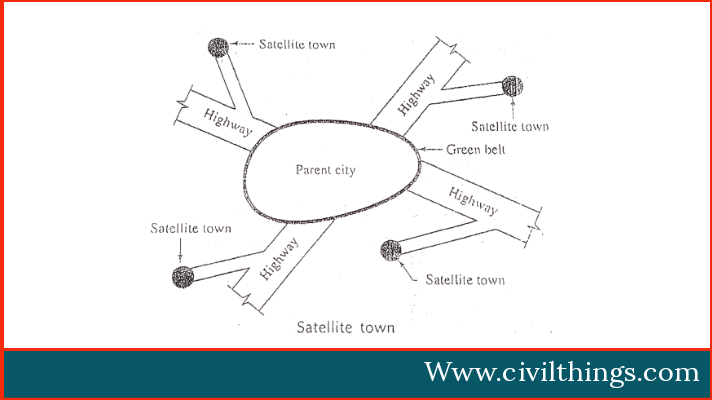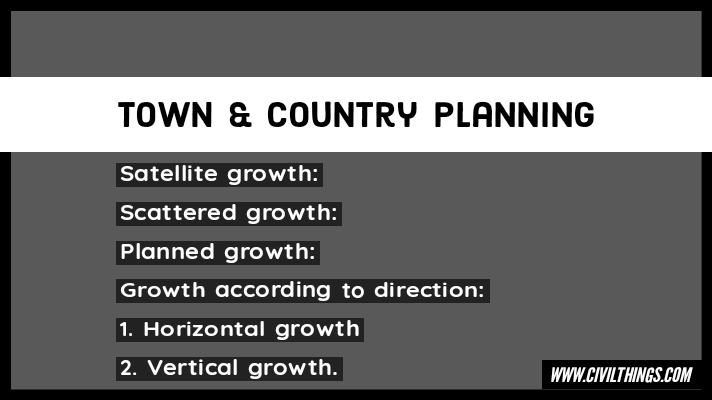- Growth Town and country planning Notes, also known as urban planning or city planning, is a discipline that focuses on the design, development, and management of urban areas and their surrounding regions. It involves creating strategies and policies to guide the growth and development of towns, cities, and rural areas in a sustainable and organized manner.
The main objective of town and country planning is to enhance the quality of life for residents and create well-functioning communities. It aims to balance various social, economic, and environmental factors to create livable spaces that meet the needs of current and future generations.
Table of Contents
| Satellite growth:
Scattered growth: Planned growth: Growth according to direction: 1. Horizontal growth |
Satellite growth:
When a town reaches a certain size, some sort of satellite growth is bound to take place. The development of a satellite town is mainly due to the metropolis and the term satellite is used to indicate a body under the influence of a more powerful body but possessing its own identity. The figure shows the development of satellite towns around the parent city.

The features of a satellite town r as follows:
1 It has its own local government and corporate life.
2 It is a town in the full sense of the word except that it depends to a certain extent upon a nearby large town or city.
3 It is connected to the parent city by local trains, buses, etc. in a manner that enables individuals to easily access the main city without encountering any obstacles.
4) It is free to decide its economic, social, and cultural activities.
5) Typically, it is located outside the designated green belt of the main city.
6) It is mainly a residential area having only local shops. schools for children, etc. As no industries are permitted, the people will have to depend on the parent city for employment opportunities.
7) It does not fall into the category of either a village or a suburb. A village has not to perform the functions of a town and a suburb is absorbed or is likely to be absorbed into another community.
8) I need not have zoning regulations.
9) Its size and development are controlled in such a way as to prevent any future competition with the main town or city, and measures are taken to ensure that it does not emerge as a rival.
10) The satellite may even be considered to be part of the market for some of the goods and services being produced in the parent city.
11) The workers living in a particular satellite may belong t the labor force of a certain industry and in that case, it will give a wider choice to the employers of sus industries for finding the best man for the job.
One significant drawback of satellite growth is the requirement for longer commutes to work. However, it is crucial to recognize that this aspect is occasionally exaggerated or overestimated. A lengthy distance does not necessarily equate to a prolonged travel time, and a longer journey is not consistently more uncomfortable than a shorter one. To accurately assess this disadvantage of satellite growth, the efficiency of different transportation modes must be taken into account.
Another aspect occasionally highlighted is the potential deprivation of entertainment and cultural activities within the satellite, which could hinder the development of a community spirit. However, it is important to note that this drawback might be excessively emphasized since the absence of community activities could be attributed to other factors, such as the absence of community centers and halls.
Scattered growth:
When a town experiences scattered growth, its expansion occurs unpredictably, leading to issues such as traffic congestion, industries encroaching upon residential areas, the emergence of slums, insufficient park spaces, and numerous other challenges that pose significant difficulties for future resolutions.
Planned growth:
In the event of planned growth, a town progresses along a predetermined trajectory envisioned by urban planners. The overall development of the town is carefully managed through the implementation of appropriate rules and regulations. This methodical expansion prevents the chaotic proliferation of activities often experienced in a typical town. Various zones, including residential, industrial, commercial, and more, are thoughtfully distributed rationally.
Furthermore, essential amenities such as street widths, drainage systems, water supply networks, parks, playgrounds, and others are provisioned to meet future requirements. The application of modern town planning concepts is readily apparent and admirable in numerous recently established towns across different regions of the world.
Growth according to direction:
Concerning direction, the growth of towns and cities can take place in the following two ways:
1. Horizontal growth of town
2. Vertical growth of town
Each of the above types of growth will now be briefly described.
Horizontal growth of town
In the case of horizontal growth, the town expands and develops horizontally in all directions. Such growth can occur in locations where available land is abundant at a reasonable cost.
The advantages of horizontal growth r as follows:
1) In general, there will be saving in cost as the buildings will usually consist of two or three stories.
(2) The involvement of highly technical personnel is not necessary for its implementation.
(3) It is possible to make the maximum possible use of natural light.
(4) The density of the population can be restricted.
(5) There is the economy of floor space as the province on of columns, lifts, etc. will not be requ red.
(6) The adjacent marginal space can be effectively utilized for the development of a garden.
The disadvantages of horizontal growth are as follows:
(1) It requires the use of more land and hence, it will prove to be uneconomical where land values are very high.
(2) The cost of the foundation per unit area will be higher.
(3) There will be absence of group living.
Vertical growth of town
In the scenario of vertical expansion, the town’s buildings are designed and constructed as multi-storeyed flats.
Such growth becomes feasible in locations where land carries a high price tag.
The advantages of vertical growth are as follows:
(1) As many people will be staying and using the common amenities of the same building, a sense of group living will develop.
(2) As the foundation cost will be distributed between all the floors, the foundation cost per unit area will be within the reasonable limit.
(3) For a floor above a certain height, the natural scenery such as sea view, river view, etc. can be enjoyed in a better way.
(4) It becomes feasible to leverage modern construction techniques to their fullest potential, including fire-proofing, sound-proofing, heat insulation, air-conditioning, high-speed lifts, and other advancements.
(5) There is a considerable saving in land and hence, it will prove to be economical where land values are very high.
(6) There will be economy in construction cost as the buildings will be designed as framed structures with repetition of a typical floor plan at each floor level.
The disadvantages of vertical growth are as follows:
(1) In case of natural calamities such as earthquakes or fires, it will be difficult for the inhabitants of the upper floors to escape safely.
(2) The density of the population will be more.
3) The design of flats will follow a standardized pattern, leaving no room for individual preferences or dislikes.
(4) The evils of group living will have to be tolerated.
(5) The failure of the lift, pump to raise water, etc. will cause great inconvenience.
(6) Residents occupying upper floors may miss out on the experience of living near the ground level, with its natural surroundings.
(7) Additionally, the inclusion of lifts, supporting columns, and other necessary features will result in some waste of floor space.

Hi! I’m Sandip, a civil engineer who loves sharing about Civil Engineering & new ideas and tips. My blog helps you learn about engineering in a fun and easy way!

